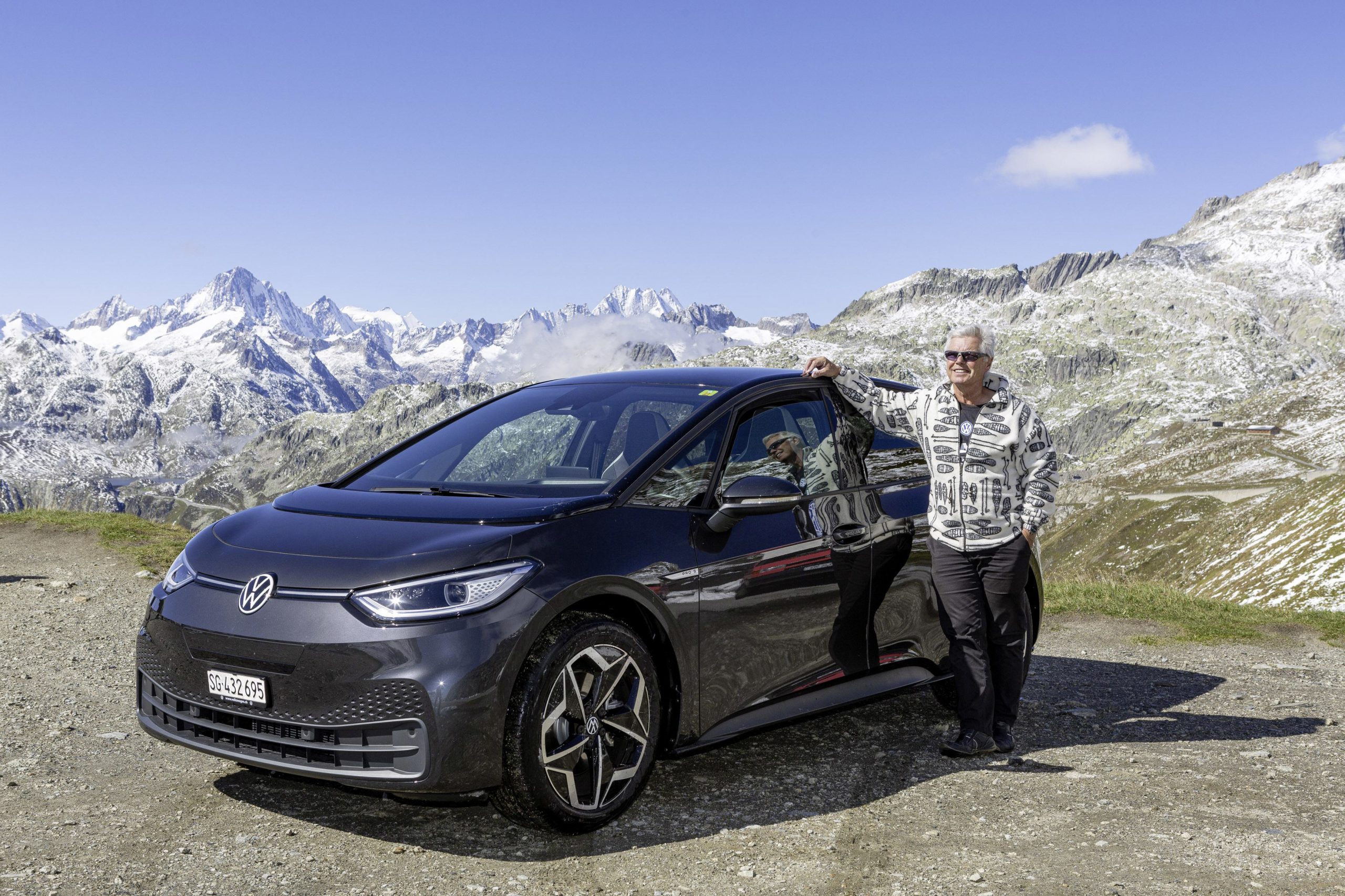 Felix Egolf, Experte für Langstreckenfahrten mit Elektroautos, auf Rekordfahrt im Volkswagen ID.3 Pro S
Felix Egolf, Experte für Langstreckenfahrten mit Elektroautos, auf Rekordfahrt im Volkswagen ID.3 Pro S
Felix Egolf is a Hypermiler from Zug. His motivation is to drive as far as possible with as little consumption as possible. In his new record attempt, the former airline pilot wants to conquer the Swiss mountains. And in the literal sense: he put together a route that includes 15 Swiss passes and leads over 600 kilometers. The deepest pass is the Hirzel at 682 meters, the highest of the Nufenen at 2480 meters above sea level. His vehicle: the ID.3 Pro S
Read here how this record run actually succeeded or download the current eMove360° magazine in german language for free.
Tailgate sealed by notary
The start takes place in Cham: A fully charged ID.3 Pro S stands in front of the AMAG headquarters. To ensure that everything is correct, a notary is present to certify the sealing of the tailgate. The weight of the car, driver and luggage is also recorded: 1925 kilograms. And the electric car starts moving almost silently. Felix Egolf drives via Lucerne and the Entlebuch over the Brünig, after which the first two-thousander awaits on the route: the Grimsel. For the almost 1600 meters in altitude and 26 kilometers from Innertkirchen to the top of the pass, 12 kWh are used, which corresponds to 16 percent of the battery capacity. Will that actually work out with the 15 passes?
A short descent is followed by an approximately 100-kilometre-long, high-alpine tour with almost 3,000 meters in altitude and the Furka (2,430 m), Gotthard (2,108 m) and Nufenen passes (highest pass at 2,480 m). This journey around the Gotthard massif “costs” only 14 kWh. The explanation: “In contrast to a combustion engine, the electric car wins energy effectively when driving downhill”. Felix Egolf The electric motor becomes a generator that feeds the battery. Thanks to the so-called recuperation, around 8 kWh flow into the batteries over these 100 kilometers.
Foresighted
The driver can use the automatic selector switch to determine how strong the recuperation should be: if you take your foot off the gas in “D” (for “drive”), this is already clearly noticeable, in “B” (brake) almost vehemently. Incidentally, the ID.3 actively helps to save energy: It has a forward-looking cruise control, which automatically slows down and recuperates in front of a roundabout or a speed reduction.
If the route drops only slightly, “sailing” is the most efficient. To do this, Felix Egolf switches to “N” mode, i.e. neutral, and thus takes all the momentum with him. “Thanks to its good aerodynamics, the ID.3 has excellent rolling characteristics,” says the Hypermiler, praising the electric VW. Only shortly before a bend does he set the lever back to B or D. The ID.3 also knows how to impress in these – with a low center of gravity and a very small turning circle, it really whizzes around the tight bends.
After a second Furka and Gotthard passage, the descent is longer: the ID.3 travels briskly down the Leventina to the southernmost and lowest point of the tour in Biasca (300 m). This has a positive effect on the battery status: the 63 kilometers from the Gotthard Pass to Acquarossa in the Blenio Valley are covered with zero consumption. In order to then tackle the ascent to Lukmanier.
Consistency brings reach
Felix Egolf also has energy-saving tricks up the hill. The most important thing: to travel as evenly as possible. Because strong acceleration and deceleration between corners costs an excessive amount of electricity. So he always tries to ramp up at an average speed of around 45 kilometers per hour. Which has another advantage: there is enough time to enjoy the breathtaking panoramas on some of the most beautiful roads in Switzerland.
Despite all the efficiency efforts, the on-board computer reports 10 kilometers before the Lukmanier pass and warns the driver to make a charging stop soon. But that doesn’t scare the Hypermiler. “He who has the height also has the depth,” he says with a laugh. In other words, where it goes up, it also goes down again, and the battery receives additional kilowatt hours – according to Felix Egolf’s calculations, 1 percent charge per 300 meters of altitude.
After 421 kilometers and 11 passes, he reaches the village of Hospental in the evening. The ID.3 shows a remaining capacity of 14.63 kWh or 19 percent. In the case of the escort vehicle, on the other hand, the tank is empty after the many meters of altitude – refilling with petrol is the order of the day.
The next morning, Felox Egolf leaves the Alps and drives towards Schwyz. That means above all: sailing. On the autobahn, Felix Egolf regularly “hides” behind trucks to benefit from the slipstream – of course always with a sufficient safety distance. No further energy is consumed in this way up to Flüelen. But all the more up to the Ibergeregg (1406 m). Shortly before the apex, the battery indicator changes from yellow to red, the charge level has dropped to below 10 percent. At least now the calculation begins.
With a display of 0 at the destination
On the last pass and after a distance of 550 kilometers, the display of the ID.3 only shows 2 percent. The Hypermiler converts this energy into a further 52 kilometers with a clever choice of route. With 0 percent battery and 0 kilometers range, Felix Egolf reaches the starting point again, where the notary is already waiting and confirming the intactness of the tank seal. The record run was impressive: 602 kilometers, 15 passes and 13,000 meters in altitude, that’s how far the ID.3 Pro S can drive on a single charge – at least when a Hypermiler is behind the wheel.